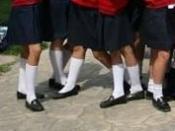If public school students had one thing over their private school counterparts it's about to change. That's right: not only are public schools notorious for large classes and limited resources but now some of them are adopting what has always been most dreaded by the youth attending private schools: school uniforms.
The very idea seems a bit strange. Agonizing over what to wear to school (and whose logo or face to wear across on your T-shirt) has always been a kind of right of passage for young people. Yet increasingly, that process is being limited on campus.
Uniforms were virtually unheard of in public schools 6 years ago. Today 11 percent of schools around the country are requiring that their students don uniforms. (According to a survey of principals conducted in May by the National Association of Elementary School Principals).
The reasons for uniforms are almost always the same. Uniforms will decrease crime and violence in schools while improving the behavior of students, say experts.
Students less concerned about who is wearing what brand name clothing are less likely to judge their fellow students or to form cliques. Also, they say, uniforms cause school pride to increase. Students feel more united, more connected, and therefore their school becomes a safer, healthier environment; students test higher on standardized tests and their grades improve, proponents of uniforms argue.
One thing that does not often get mentioned by adults and experts is the fact that uniforms are now being made by huge clothing manufacturers like DKNY, Esprit, and Bugle Boy. The NPD Group, a market research company in New York, estimated that parents spent $900 million on uniforms for elementary school children in 1998. That comes out to about 7 percent of the total amount spent on children's clothing and this number has...


